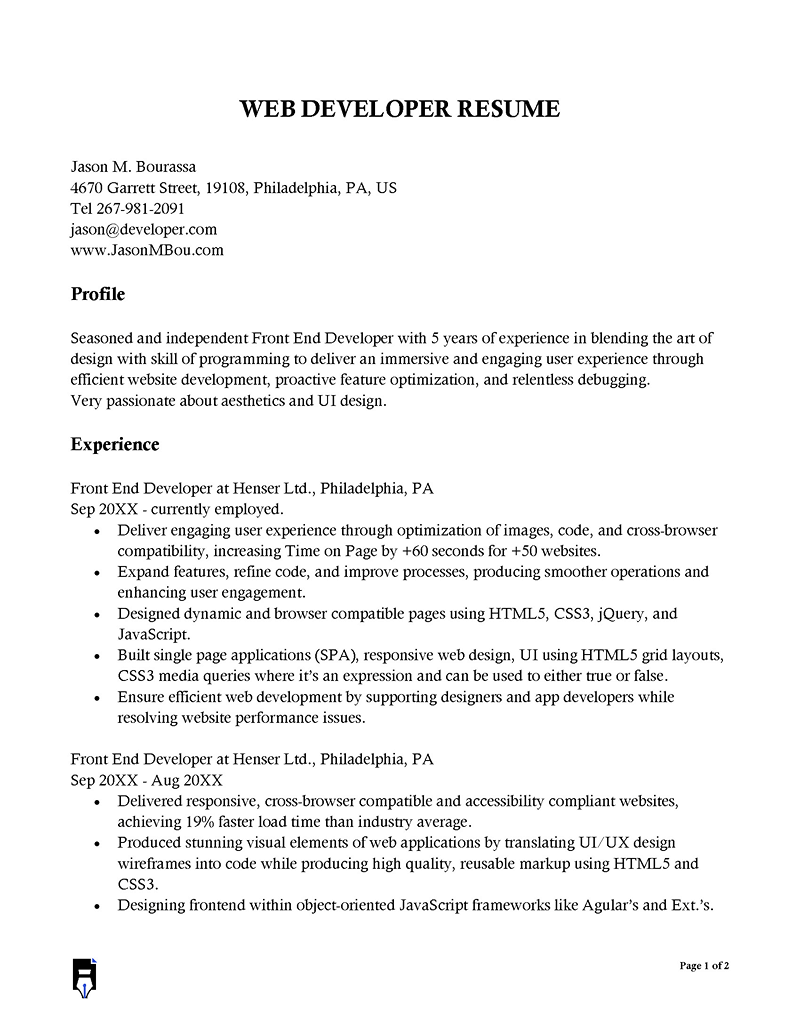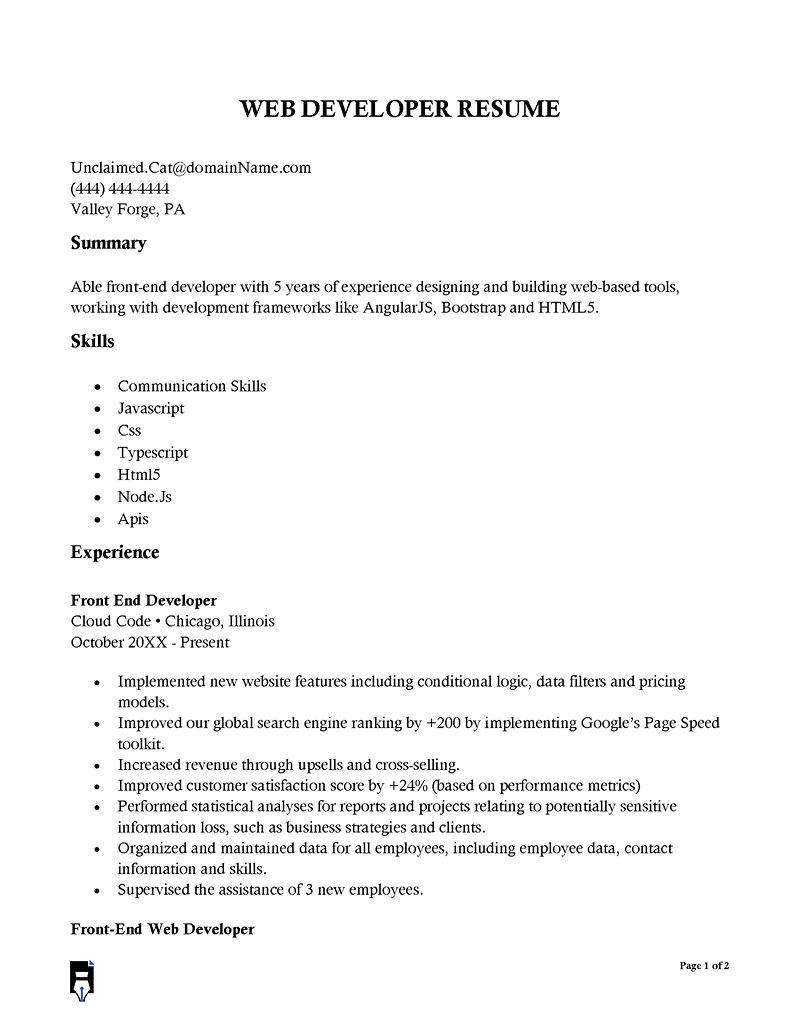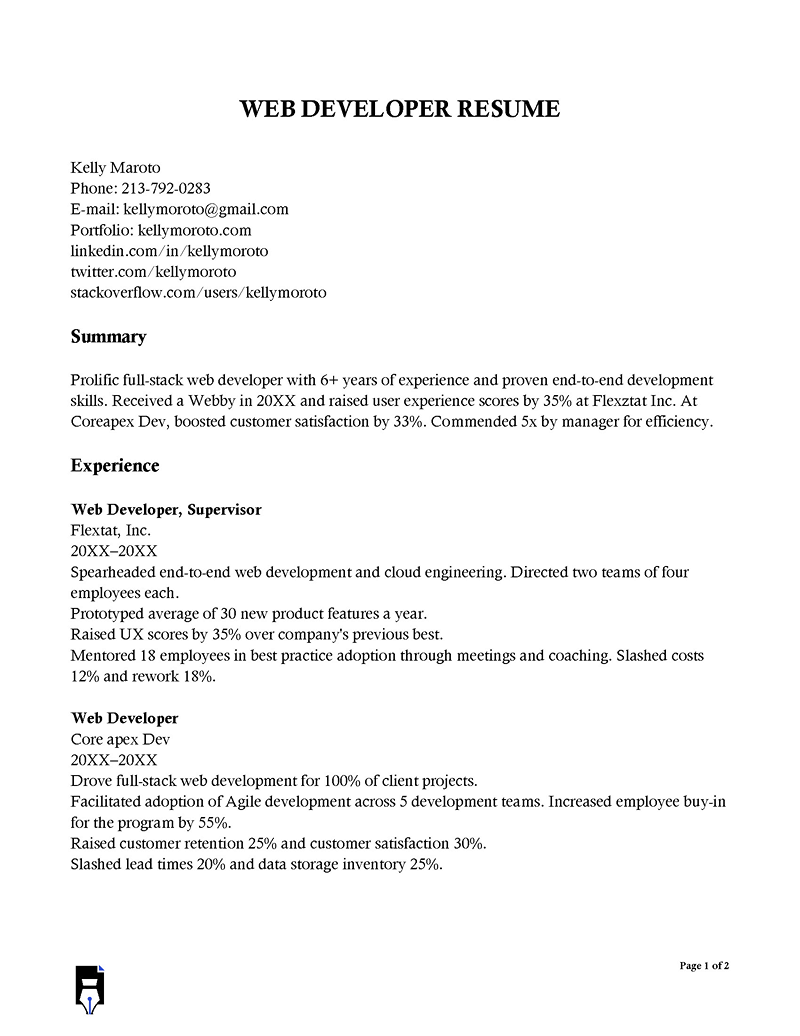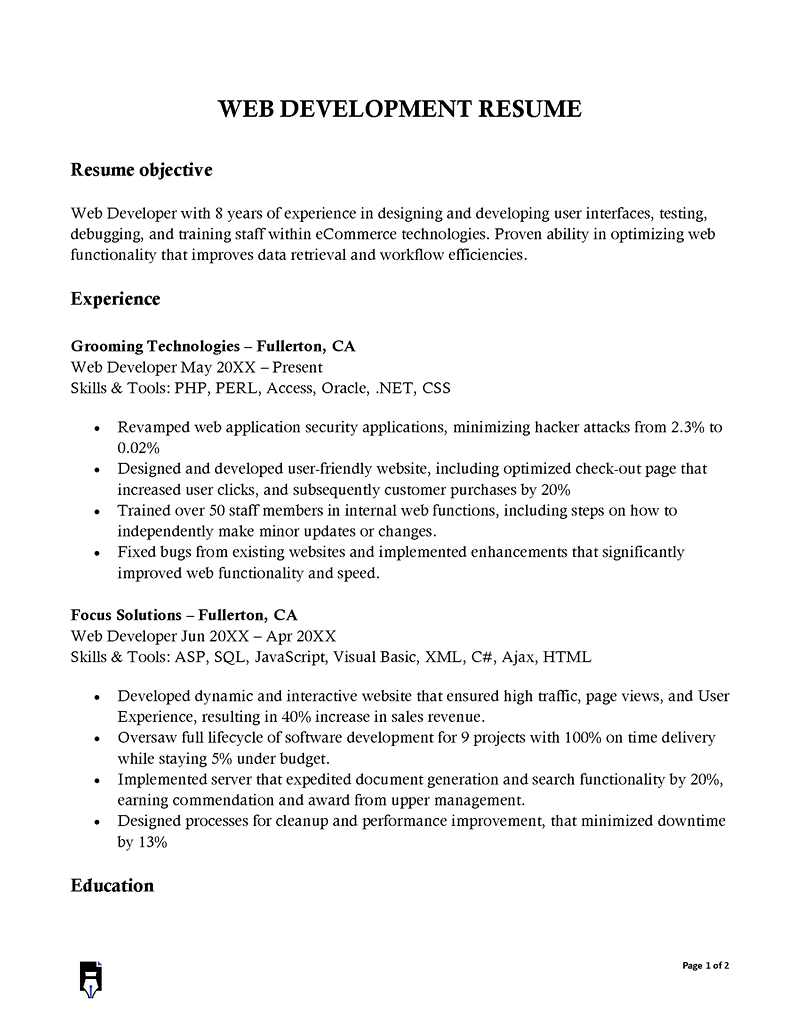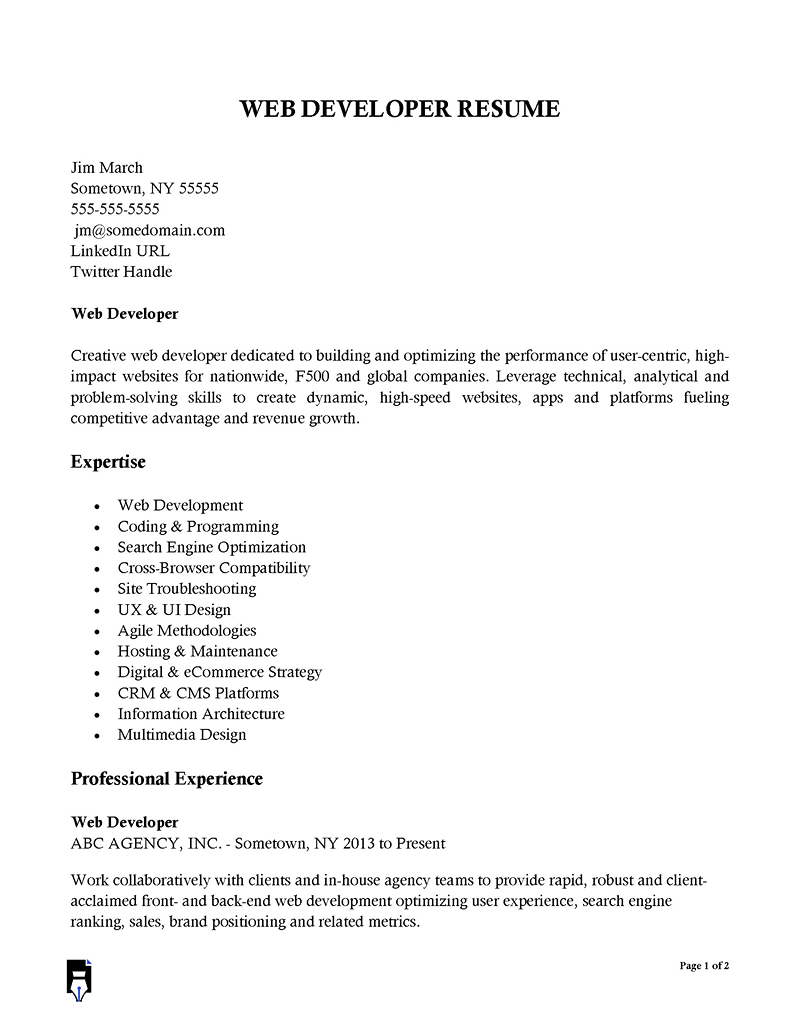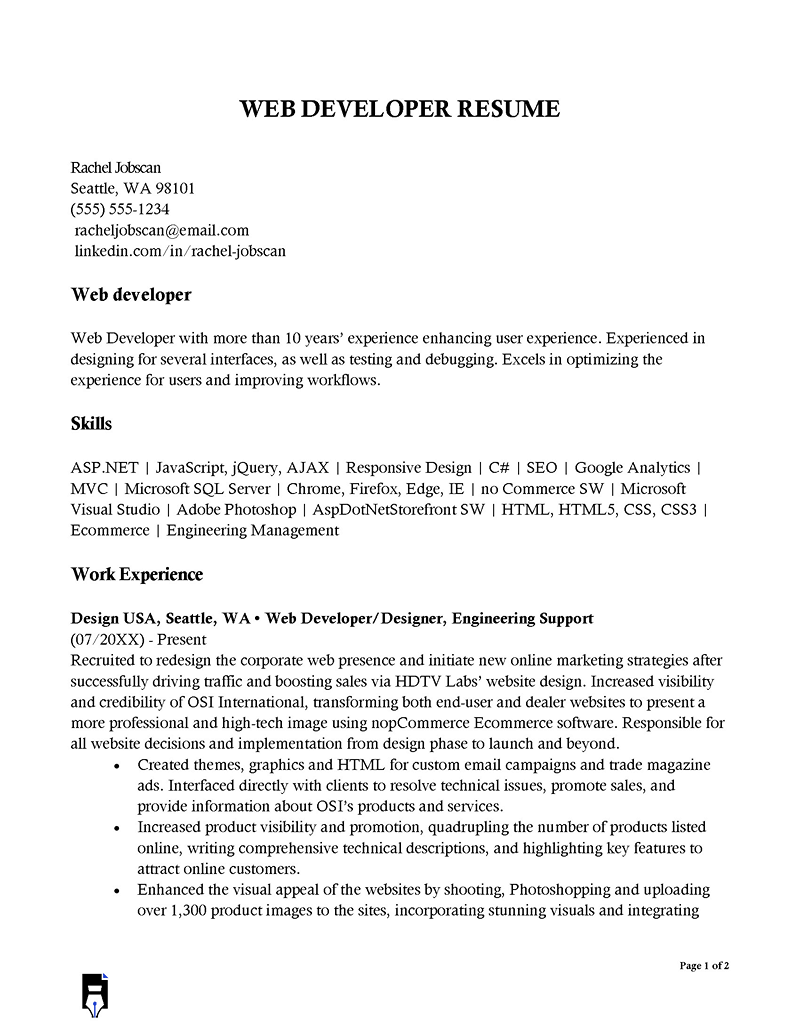A web developer’s resume is a document that outlines an applicant’s work experience, education, and skills that are relevant to the position.
The resume is used to give employers an idea of the candidate’s suitability for a web development role and help them determine whether they are the best candidate for their company.
The web developer’s resume should highlight the technical skills and experience relevant to the position they are applying for. This may include experience with specific programming languages, frameworks, and databases and the ability to design and develop websites and web applications.
Web developers utilize the most current software in the industry to design, develop, and maintain websites that deliver a superior user experience, helping to consistently attract the target audience the website is attempting to reach.
In addition to technical skills, a web developer’s resume should include information about any relevant education or training and any professional certifications or awards the applicant may have received.
A well-drafted resume can help you secure an interview, so you must take the time to ensure that it is carefully constructed. To help you do this, this article breakdown everything you need to know about web developer resumes, including what to do before drafting the resume, the different sections that should be included, and the best practices to follow when creating the resume.
Statistical insight: The US Bureau of Labor Statistics estimates that the demand for web developers will increase significantly more than the average by almost 8% between 2019 and 2029. A survey conducted by Stack Overflow in 2017 determined that the demand for web developers and its popularity was higher. In the US, 83% of web developers were fully employed, and another 10% worked as freelancers or on a part-time basis.
Download Free Templates
Following are the web development resume templates that you can download for free:
Pre-Planning a Web Developer Resume
Before you begin the process of creating your resume for the web developer position, it is important to take some time to plan carefully and prepare. This will help you create a robust and effective resume that will appeal to potential employers and increase your chances of getting an interview or being hired.
Here are three key steps you should consider before drafting the resume:
Step 1: Review the job description
The first step in pre-planning a web developer resume is carefully reviewing the job description for the position you are applying for. This will give you a clear understanding of the skills and qualifications required for the role and the responsibilities and duties you will be expected to perform. Paying close attention to the job description can tailor your resume to match the position’s requirements and increase your chances of being considered for the job.
Step 2: Research the company
In addition to reviewing the job description, it is also helpful to research the company you are applying to. Knowing a company’s culture, values, and type of work can help you tailor your resume to better fit their needs and expectations. You can also use this research to highlight any relevant experience or skills that may be particularly relevant to the company.
Step 3: Draft a master resume
Before you begin customizing your resume for each specific job application, it can be helpful to create a master resume that includes all of your relevant education, skills, and experience. This can serve as a starting point for creating tailored resumes for specific job applications and make applying for jobs easy.
In addition, by having a master resume available, you can quickly and easily create customized resumes for each job you apply for, rather than starting from scratch each time. When drafting your master resume, you should keep in mind the different web developer positions, i.e., full-stack, back-end, front-end and web design.
Sections of Web Developer Resume
A comprehensive web developer resume should emphasize your technical skills, relevant experience, and educational background in an easy-to-read format that effectively communicates your suitability for the role.
Here is a brief overview of each section of a web developer resume, along with some examples of what to include and what to avoid:
Header
The header of a web developer resume should include your name, contact information (such as your phone number and email address), and any relevant links (such as your website or LinkedIn profile).
Below are examples of the right and wrong ways to write the header:
Wrong:
John Doe
555-555-555
Right:
Web Developer
John Doe
555-555-555
[email protected]
github.com/johndoe
Linkedin: https://linkedin.com/in/john-doe-02a0b129
Profile/Summary
The profile or summary section of a web developer’s resume should provide a brief overview of your skills, experience, and goals as a web developer. Your professional summary is an opportunity to showcase your qualifications and value effectively to the hiring manager. It should include a brief overview of your professional experience, key accomplishments, and relevant technical skills or languages that you are proficient in.
See the examples given below:
Wrong:
I am a web developer with some experience. I know a few things about coding and am looking for a job.
Right:
I am a highly skilled web developer with 5 years of experience building and maintaining web applications. In addition, I am proficient in HTML, CSS, JavaScript, and several other programming languages. I seek a challenging and rewarding position where I can adequately utilize my skills and continue growing as a developer.
Web developer experience
A web developer’s resume’s experience section should list your previous web developer employment, including the company’s name, job title, and a brief description of your responsibilities. In addition, it is essential to highlight any projects or accomplishments that showcase your skills and abilities as a web developer.
See the examples given below:
Wrong:
Web Developer, XYZ Company (2015-2016)
-Did some coding stuff and web development
Right:
Web Developer, ABC Company (2019-2020)
-Developed and maintained the company’s e-commerce website using HTML, CSS, and JavaScript
-Implemented responsive design and accessibility features to improve user experience
-Collaborated with cross-functional teams to identify and prioritize development tasks
Education and certification
The education and certification section of a web developer resume should list any relevant degrees or certifications you have obtained. This can include a computer science degree or a specific programming language certification. It is vital to include the institution’s name and the year you obtained the degree or certification.
Here is an example:
Wrong:
Bachelor’s degree in Computer Science, UCLA (2017-2021)
-Coursework: web stuff, data structures, HCI
-Certification: Web Developer, XYZ Institute (2021)
Right:
Bachelor of Science in Computer Science and Mathematics, University of California, Los Angeles (UCLA) (2017-2021)
-Major: Computer Science
-Relevant coursework: Web Development, Data Structures, and Algorithms, Human-Computer Interaction
-Certifications: Certified Web Developer, XYZ Institute (2021)
Statistical insight: According to data obtained in 2019, 45.3% of developers have the equivalent of a degree, and 22% are master’s degree holders. 85.5% are self-taught developers, with 60.1% doing so through online programs. The same percentage of the surveyed developers had no higher education diploma.
Skills section
To write a web development resume skill section, start by categorizing your technical skills by proficiency and type. For example, you could create categories like “Programming Languages,” “Web Technologies,” and “Database Systems.” Then, within each category, list your skills and proficiency level. For example, under “Programming Languages,” you might list “JavaScript (Expert),” “HTML/CSS (Proficient),” and “PHP (Familiar).”
Briefly include your soft skills as well. These could be skills like “Communication,” “Teamwork,” and “Problem-Solving.”
Here is an example of how this section could look in your resume:
Technical skills:
| Category | Skill | Proficiency |
| Programming | JavaScript | Expert |
| Languages | HTML/CSS | Proficient |
| PHP | Familiar | |
| Web Technologies | React | Proficient |
| Node.js | Proficient | |
| Express | Familiar | |
| Database Systems | MySQL | Proficient |
| MongoDB | Familiar |
Soft skills:
| Skill | Description |
| Communication | Strong verbal and written communication skills, with ability to communicate technical concepts to both technical and non-technical audiences effectively. |
| Teamwork | Proven ability to work effectively in a team environment, with strong collaboration and interpersonal skills. |
| Problem-Solving | Demonstrated ability to troubleshoot and resolve technical issues, with a strong focus on finding creative solutions to complex problems. |
Projects
In the projects section of your web developer resume, you should include a list of the projects you have completed as a web developer. For each project, you should include a brief description of what you did, the technologies you used, and any notable achievements or outcomes.
Here are some wrong and right examples of how you can include projects in your web developer resume:
Wrong:
-Worked on a website.
-Developed a project without specifying the technologies used or any notable achievements.
Right:
-Developed a responsive e-commerce website for a local boutique using HTML, CSS, JavaScript, and PHP. Implemented a payment gateway and integrated it with the client’s inventory management system.
-Created a website for a non-profit organization using WordPress. Customized the theme and added functionality using plugins and custom code.
-Worked on a team to build a social networking platform using React and Node.js. Contributed to the front-end design and implemented server-side features using Express and MongoDB.
8 Best Practices for Creating Appealing Web Developer Resume
To create a compelling resume that is sure to capture the attention of a potential employer, it is important consider the following best practices:
Tailor your resume to the job
Make sure to customize your resume to fit the specific job or company you are applying to. This means highlighting the skills and experiences most relevant to the position and adapting your resume to match the job description and requirements.
Structure your content
Use a clear and logical structure to organize your content and make it easy for the reader to find the information they want. For example, consider using headings and bullet points to break huge blocks of text and make the resume more visually appealing.
Use strong action verbs
Use active language and strong action verbs to describe your responsibilities and achievements. Examples include “developed,” “designed,” “implemented,” “managed,” and “analyzed.”
Quantify your achievements
Use numbers and statistics to illustrate the impact of your work and demonstrate your value as a web developer. For example, you might mention how many users a website or application you developed had or how much time you saved through implementing a new system.
Write strong accomplishment statements
Use specific and concrete examples to show the employer what you have achieved in your previous roles. Focus on the results you achieved and the problems you solved rather than just listing your duties and responsibilities. Accomplishment statements on resumes typically follow the format of including an action verb, describing the task performed, and detailing the resulting outcome.
Format your resume
Use a clean, professional format for your resume. This can include using appropriate margins, font sizes, line spacing, and aligning your text consistently. Ideally, you should use the chronological resume format if your career has followed a linear path of employee positions. Use the alternative resume format if you are an independent consultant or looking to radically depart from your current position.
Stats: The developer market is the most lucrative job market in the US. However, of all applicants, 21% ran into problems or failed to pass the ATS due to various factors, such as confusing layouts, images, or charts.
Include keywords to make it ATS-friendly
Most companies and recruitment agencies use applicant tracking systems (ATS) to scan resumes for keywords that match the job requirements. So, include relevant keywords in your resume to increase the chances that these systems will review it.
Statistical insight: According to a US survey, 75% of the submitted resumes are never seen by human eyes. Different ATS systems review most of them. This is why it is imperative to understand how the ATS works.
Use a template
A resume template can help you create a professional-looking document and ensure that your resume has a consistent structure and layout. Choose a template that is easy to read and presents your information in a clear and organized way.
Key Takeaways
- Review the job description to understand what you’ll be asked to do and the skills that the company requires.
- Research the company that you want to work for online. You can use search engines like Bing, Google, and Yahoo to find information about them, their products, or their competition.
- Create a master resume of your relevant education, skills, and experience. This can be used as the starting point for each job application you apply for.
- Tailor your resume to meet the specific job requirements and skill sets. Highlight any experience or skills that make you an ideal candidate.
- When drafting a resume, it is essential to consider keywords relevant to the role. Make sure that you include these when listing your skills and experience.
- It is helpful to include a portfolio of work on your resume. This can highlight your skills and experience and demonstrate why you are a good fit for the job to the hiring manager or employer.
- Make sure to include contact details for your references and other information like addresses and phone numbers on your resume.
